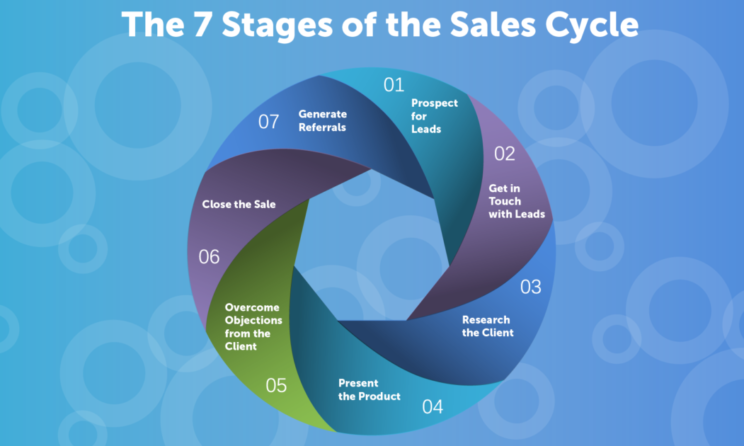
Businesses that aim to achieve growth and development with good sales follow the ‘Sales Cycle.’ A well-defined and detailed sales cycle is a crucial asset for the company. Establishing a defined sales cycle for the company is vital because it helps identify the area of improvement.
When you can break your selling process into easy-to-measure steps, you will be able to gather data and metrics accordingly. This is a comprehensive guide about the sales cycle and its stages.
Have you ever thought about the sales cycle of your business? Many entrepreneurs don’t. This is because they are too busy to keep the company running from day to day.
It is a fact that sales don’t just happen. Businesses have to reach new customers, retain existing ones, and increase revenue. For that, it is important to understand the concept of the Sales Cycle and its importance.
Understanding the Sales cycle is crucial for increasing sales, but it is imminent when you are training the new sales reps. It is important when you want to measure sales efforts. And it plays a huge role when you want to define and establish a sales strategy and sales roadmap for the growth and development of the business.
What is Sales Cycle?
A Sales cycle is a step-by-step process or series of specific steps needed to acquire new customers, that is, steps taken by sales reps to make sales. Individual steps for the sales cycle will differ from business to business.
Example: Some sales businesses employ door-to-door knocking for leads, some generate leads through online research, and some do generation with targeted calls.
Most of the sales cycle begins with prospecting and ends at closing the deal or sale and getting referrals for future leads. Businesses that are sales organizations aim to have a short sales cycle for sales reps to move quickly and efficiently through the east step to close deals.
The B2B sales cycles are often longer because it’s more research-intensive and requires additional detailing and assurance before committing to sales by other businesses.
The Sales cycle is defined as a series of steps and stages that are needed to acquire new customers. IT aligns with the sales funnel and has designated activities that sales reps must complete before they advance to the next stage towards closing deals or sales. Each of the steps has a particular function or purpose.
Importance of Sales Cycle
Why is it important to understand the sales cycle? Why is it important to have an established, defined, and detailed sales cycle of your company? Answers to these questions are:
It helps to identify areas of improvement:
Break up the selling process into easy-to-measure stages of steps, and it will allow you to gather data and metrics. In this process, the CRM-Customer Relationship Management software solution helps to automate the functions and collect data without much additional work. The Auro CRM is the pioneer to automate the customer sale cycle journey and provide the sales reps with insights that will help them make better sales.
You can identify a point in which the sale tends to fall off through the cycle. When you know the sales cycle, you will be able to highlight the steps that lead to a deal and steps that don’t lead to a deal. This will allow you to improve upon the methods and allocate better resources and team members to increase sales by increasing conversion rates.
AuroCRM has retail CRM that is immensely expertise with tools and features that help to improve conversion rates and thus increase sales to generate great revenue.
Making Training Easier:
A well-defined, designated and designed sales cycle will help your company to have streamlined training to offer with a set of templates or roadmap. Following the precise template or roadmap, new sales reps will adhere to it and understand the selling process much better and quicker. They will be able to pinpoint steps in the workflow, and the company will know if, when, and where there is a need for additional training.
Forecast of future sales:
The data from the sales process will help you better predict future sales. Detailed data can be used for the identification of the numbers of sales that each employee is making on a monthly basis. In addition, it will help you identify the average length of the sales cycle and the sales that are most likely to succeed after the buyers proceed to a certain step in the sales cycle of the buyer’s journey.
Seven Sales Cycle Stages:
The Sales cycle differs from one business to the next. Some sales cycle is longer or shorter. For example, when a buyer is buying a car, it will take longer to decide. There will be hesitations to make a purchase. But someone buying a t-shirt will be quick and the hesitation level will be less. The potential buyers go through a sales cycle, long or short. They process through each stage of the sales cycle. Sales reps and companies can help buyers to make progress and provide the best possible customer experience.
Ideally, it is to help buyers make progress quickly to make the sale. Though sales cycles vary, here are the most common stages of the sales cycle:
Step 1: Initial contact
Step 2: Qualify Compatibility
Step 3: Analyze needs/Wants
Step 4: Make sales pitch
Step 5: Deliver proposal
Step 6: Negotiation
Step 7: Close the deal/Sale
Initial Contact:
This is the start of the sales process. This stage begins with identifying the target audience as you create buying personas. The Buyer personas can be described as ideal customers with more information such as interests, needs, wants, pain points, and ways to help them.
The sales reps use these buyer personas to identify the leads and cold prospects that match closely with the ideal customer personas and profiles. Finding cold prospects i.e. leads that are not marketing qualified leads, your sales reps will search social media networking sites like LinkedIn or through various referral sources. This is one of the ways to make a list of potential leads to contact.
More marketing qualified leads can be provided to
sales reps with the refined sales funnel. It means sales reps spend less time prospecting and spend more time selling.
Qualify Compatibility:
The sales reps will have a list of leads by this stage. The next step is to determine where potential customers are present in the buyer’s journey and if they are aware of what they need or searching for a solution to their problem.
Answer to these questions will help the salesperson know what is needed or want of the customers. For example, if customers have accessed offers from a website or social media page, then the salesperson will know that the potential customer is ready to discuss and know more about the product in detail. You will know the prospective buyer is doing research and is not ready to choose a product yet. At times the prospective customer needs more time before they get qualified and advance to the rest of the sales process.
Sales reps need to make first contact as soon as possible so that your brand and company are considered when a prospective customer is ready to buy.
The study states that making contact with prospective buyers within an hour or less is optimal. Automated Marketing with the help of CRM solutions helps prioritize follow-ups that ensure potential customers that don’t fall through the cracks. The Auro CRM assists your business to help your customers move ahead in the buyer’s journey.
Qualifying lead is when sales reps do additional research which determines whether potential customers meet the basic qualification for the product and service.
Let us take an example: if your company is selling software to other companies, you can start with knowing the prospective client has compatible technology for your product.
Analyze Needs/Wants:
Once your sales reps have contacted prospective leads, it is time to qualify them. You can do cold calling. In this stage, you want to ask the decision-makers various questions regarding the intent of purchase and to know if prospective is a good fit or not for the company.
During this stage, you will like to know more about the needs/ wants of the buyer. You need to accurately access the lead if they are ready to move forward towards making a purchase.
Today this stage is more about anticipating the needs and wants of the customers. Anticipation of needs helps marketing people to plan content and campaign accordingly. Likewise, it helps sales reps to create offers and deals accordingly.
Making Pitch:
Now that you know the lead is interested, you need to start nurturing them until the time is right to close the deal. In this stage, Personalization plays a huge role to make prospective leads feel valued by the company. Personalization and customization during this stage are critically important for building better customer relationships. The CRM and Retail CRM helps in improving customer relationship management. CRM plays a huge role in giving the best customer experience.
In this stage, the focus should not be on your product’s features, but the focus must be on the prospective leads’ needs and how you can help solve the problems.
Sales reps can provide customized sales presentations or personalized email campaigns and nurture leads. The integrated Auro CRM and marketing automation platform provides tools to initiate phone calls, retarget social media ads to prospective leads. The key is to engage with prospective leads so that your brand, products, services, and company stays on top of customers’ mind.
The goal of the sales pitch is to convince prospective clients that your interest is in line with their own. In addition, research gathered during the prospective and qualifying leads is used to make sales pitches better engaging and personalized.
Deliver Proposal:
You need to first figure out what is preventing potential customers from purchasing. Is it because of pricing, compatibility, scalability, and offers from competitors? You need to address these concerns honestly and show enthusiasm towards your prospective customers.
You need to keep track of pain points across prospects so that you can provide solutions of answers to these for future customers in your presentation.
Leads that ask for demos, make inquiries or ask for trials, or inquire more about prices and features, then the customer is typically ready to make a purchase. It is time to make a sales pitch which is appropriate to conclude with an attractive and competitive offer.
This step allows you to nurture; you need to ease a prospect further down the sales pipeline and towards closing. You must be able to answer any lingering doubts or any new questions from prospective buyers.
Negotiate:
Many times leads push back when you make an offer. This is because they wish to negotiate. They can argue about the price being high and compare it to competitors’ offers and rates. May be proposal doesn’t include key products and services they might want.
These objectives can be overcome by offering something valuable to the prospective customer, but it should be minimal cost to you like free delivery or a longer support contract. The Retail CRM provides insights that will aid you to formulate such negotiations. The Retail CRM tracks these negotiations as it helps to improve sales reps closing techniques and train them for future engagements.
Close Deal:
The closing deal should happen naturally. If you have helped a customer with previous steps and followed it, then closing the deal will be easy. Ensure you have done the paperwork and accurate billing etc. all customers have to do is sign.
This is the final stage as the prospective customer makes the purchase and becomes a customer. It is an ideal step, but closing a deal often does not happen. The sales reps need to learn from it. The CRM tools help better know why it fell out and help complete the deal in the future.
After closing, deals sales reps can also ask for referrals. Sales reps ask new customers to refer them to their friends, relatives, and colleagues that are additional prospective buyers. By using the information and referrals from customers help to generate new leads. The sales team will jumpstart their prospecting work and dive into the sales cycle again.
CRM helps to improve the sales process. With the right CRM, it will automate marketing, help with customer customization solutions, lead generation, and drive sales cycle, and manage customer relationships. In addition, you will be able to make data-driven decisions with Auro CRM as it helps at every stage of the sales process.
How to improve the Sales cycle with AuroCRM?
- Reduce Non-sale activities through automation
- Lead Management with automated follow-up reminders, tracking with CRM and keeping the sales pipeline accurate
- Simplify scheduling with CRM as it offers setting up meetings and follow up built-in
- Leverage proof points such as reviews, customer success stories, user-generated content, and testimonials to promote the brand and products.
- Train sales team





